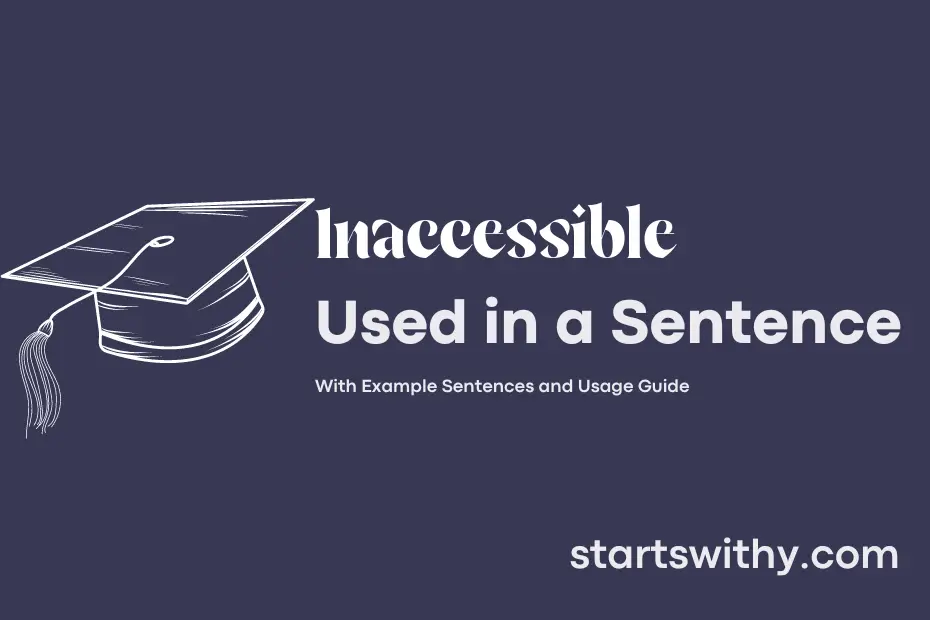Have you ever encountered a challenging word that seems out of reach or difficult to understand? This is where the word “inaccessible” comes into play. “Inaccessible” refers to something that is not easily reached, approached, or entered.
Examples of “inaccessible” situations can range from physical barriers like locked doors to abstract concepts that are difficult to comprehend. Understanding this term is crucial for accurately describing things that are hard to access or beyond reach.
7 Examples Of Inaccessible Used In a Sentence For Kids
- The top shelf is inaccessible to me.
- The candy jar is inaccessible because it’s too high.
- The treehouse is inaccessible without a ladder.
- The remote control is inaccessible on the table.
- The bird’s nest is inaccessible up in the tree.
- The treasure chest is inaccessible deep underwater.
- The mountain peak is inaccessible without climbing gear.
14 Sentences with Inaccessible Examples
- The library’s archives are inaccessible to students without prior permission.
- Due to technical issues, the online study material is currently inaccessible.
- The professor’s office hours are scheduled at a time that is inaccessible to many students due to their class schedules.
- The rooftop terrace of the college building is inaccessible to students for safety reasons.
- Some of the research papers required for the assignment are inaccessible through the university’s database.
- The sports facilities are inaccessible to students during exam season.
- The study group meeting was held in an inaccessible location for students using wheelchairs.
- The academic journals in the restricted section of the library are inaccessible to undergraduate students.
- The extra study materials provided by the professor are inaccessible to those who missed the lecture.
- The study cubicles in the library that offer complete privacy are inaccessible to students without a reservation.
- The off-campus seminar was held in an inaccessible location for students without transportation.
- The rooftop garden on campus is inaccessible to most students because it is under renovation.
- The software required for the assignment is inaccessible to students who do not have access to a computer lab.
- The online quiz platform was temporarily inaccessible during a scheduled maintenance period.
How To Use Inaccessible in Sentences?
To Inaccessible means something is not able to be reached or obtained. When using this word in a sentence, it is important to place it correctly to convey the intended meaning. Here’s a guide on how to use Inaccessible effectively:
-
Identify the thing that is not reachable or available. This could be a physical location, an object, information, or even a person.
-
Determine the context in which the Inaccessible item is being talked about. This will help you frame your sentence properly.
-
Start your sentence with a subject that relates to the Inaccessible item. For example, “The treasure chest was inaccessible due to the locked door.”
-
Follow the subject with a verb that describes the action or state of the Inaccessible item. This will help clarify the situation. For instance, “The bridge was inaccessible after the storm washed it away.”
-
You can also use adverbs to provide more detail about the Inaccessible item. For example, “The top shelf was completely inaccessible without a ladder.”
-
Make sure the rest of your sentence supports the idea that the Inaccessible item cannot be reached, touched, or obtained.
By following these steps, you can effectively use the word Inaccessible in a sentence to clearly communicate that something is not within reach or unattainable.
Conclusion
In conclusion, sentences with inaccessible refer to instances where information or resources are not easily obtainable or reachable. This term is frequently used to describe content that cannot be accessed or understood due to various barriers, such as physical obstacles, language differences, or technological limitations. When content is inaccessible, it restricts individuals from fully participating or engaging with the material, which can hinder learning, communication, or inclusion.
Addressing issues of inaccessibility is crucial for ensuring equal opportunities and access for all individuals. By making content more accessible through simpler language, alternative formats, or improved infrastructure, we can break down barriers and create a more inclusive and equitable society where everyone has the chance to benefit from the information and resources available.



